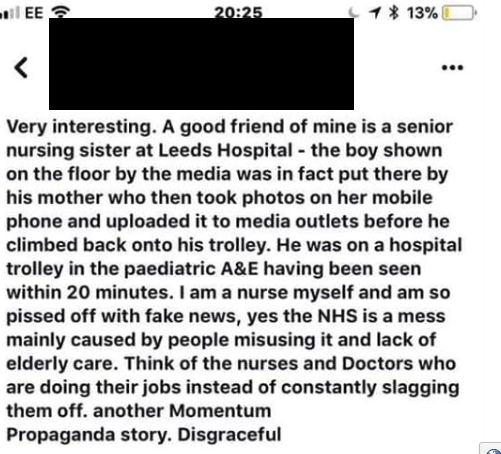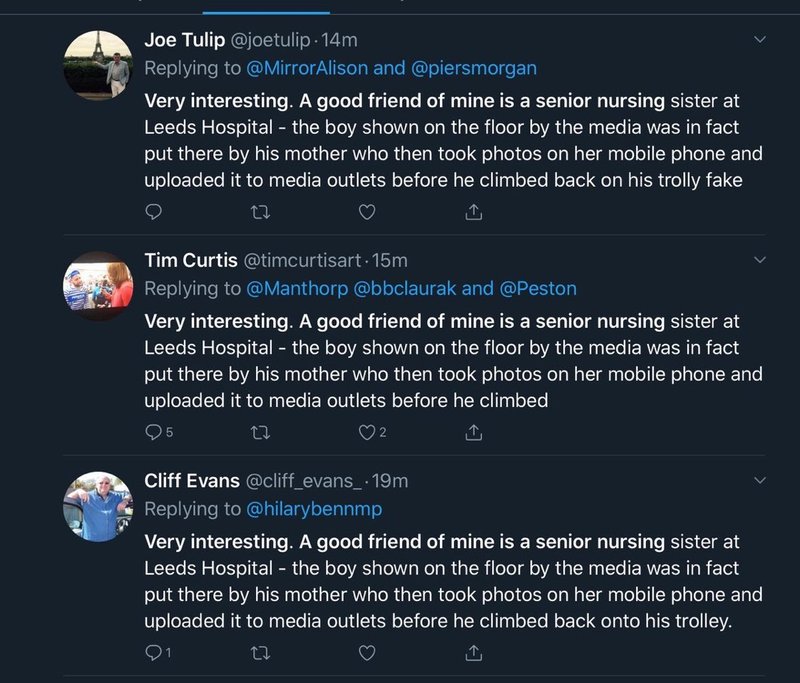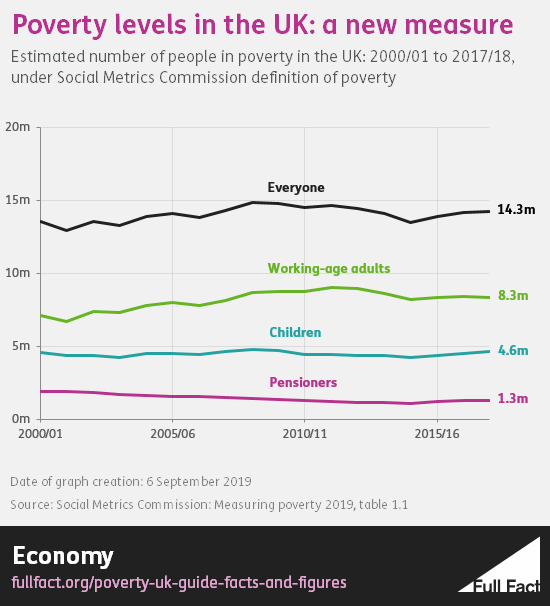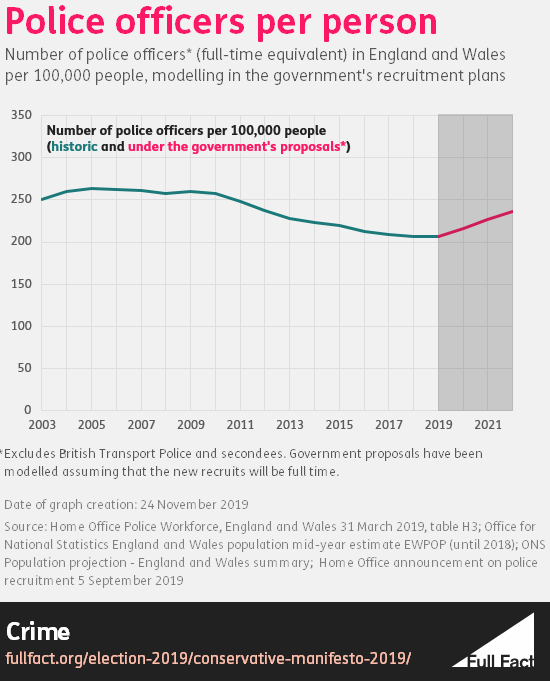These are the facts that we know about the photo of the boy in Leeds General Infirmary
A photo of a boy lying on the floor of Leeds General Infirmary has become one of the most contentious stories of the election campaign.
Here’s what we know about the photo. We will continue to update this when we learn more.
The story first appeared in the Yorkshire Evening Post. The reporter who broke the story, Daniel Sheridan, has said on Twitter that he waited for the hospital to confirm the incident.
Sarah Williment told the publication that her son, Jack, had been taken to hospital on December 3rd with suspected pneumonia. Jack was moved from a bed due to an emergency arrival and put in a room without a bed. Jack, wanting to sleep, had to use the floor. He stayed overnight, but according to Mrs Williment, it took him 13 hours after arrival to be given a bed on a ward.
The article also included a statement from the Dr Yvette Oade, the Chief Medical Officer of the hospital’s NHS trust, apologising for what happened and confirming key aspects of the story.
That statement says, in part: “Within four hours a decision was made to admit Jack to our Children’s Assessment and Treatment (CAT) Unit for further monitoring overnight. Unfortunately, the unit was also experiencing exceptionally high levels of demand which meant that Jack was required to wait in the clinical treatment room in the Paediatric Emergency Department until a bed became available. Jack was admitted to the CAT Unit later that evening and was discharged home the following morning after a medical review.
“We are extremely sorry that there were only chairs available in the treatment room, and no bed. This falls below our usual high standards, and for this, we would like to sincerely apologise to Jack and his family.”
Health Secretary Matt Hancock also issued an apology after visiting the hospital.
Following the story receiving national coverage, a number of people on social media claimed to have information that countered the mother’s story.

A post on one woman’s Facebook page claimed that she knew a nurse at the hospital, who supposedly said that the boy actually had a trolley and was placed on the floor by his mother for the purpose of the photo (a claim that seems to be contradicted by the statement from Dr Oade). This account of the incident was copied and pasted by numerous other people and quickly spread across social media, making it look as though many people were claiming to know the situation.
The woman has since told the Guardian that her account was hacked and that she knows nothing about the situation.

Many social media users have suggested that these accounts are 'bots', but we have seen no evidence to date that they are automated. As we've written before, what can appear to be bot-like behaviour is often carried out by real humans.
There has been some confusion as to whether a hospital trolley bed can be seen in the photo (which shows an item of furniture with wheels in the upper right corner). There's no reason to believe that this is a trolley bed; a lot of hospital equipment has wheels so it can be moved to where it is most needed. The equipment in the photo also appears to have shelves, suggesting it is unlikely to be a trolley bed.
Honesty in public debate matters
You can help us take action – and get our regular free email
Subscribe to weekly email newsletters from Full Fact for updates on politics, immigration, health and more. Our fact checks are free to read but not to produce, so you will also get occasional emails about fundraising and other ways you can help. You can unsubscribe at any time. For more information about how we use your data see our Privacy Policy.
The punch that never was
Earlier today many senior political journalists reported that a Labour activist punched an aide to Conservative Health Secretary Matt Hancock while he was visiting a hospital in Leeds.
This did not happen.
Video footage shows Mr Hancock’s aide walking into the outstretched arm of a man who had previously been shouting at Mr Hancock.
Mr Hancock was visiting Leeds General Infirmary after the Yorkshire Evening Post (and subsequently the Daily Mirror) published images of a four year-old boy with suspected pneumonia sleeping on the floor of the hospital because of a lack of bed space.
(The boy turned out not to have pneumonia, as the YEP story makes clear; an earlier version of this post left out the word "suspected".)
9 December 2019, 1.43pm (updated)
Are there more food banks than McDonald's restaurants in the UK?
There’s a claim circling today that there are more food banks in the UK than McDonald’s restaurants. Based on the figures we’ve seen, it is accurate.
There are approximately 1300 McDonald’s restaurants in the UK, according to the company.
A recent report by the House Of Commons Library found that there are at least 2000 food banks in the UK. This figure is an underestimate, as it primarily comes from the Trussell Trust and the Independent Food Aid Network, and does not include every type of food bank, such as food banks operating in schools.
One of the Twitter posts also attempted to show food bank growth. According to the figures in one report from the Trussell Trust, the tweet underestimates food bank numbers in 2011 at least, and again, it’s likely there are non-Trussell food banks not accounted for.
Related topics
McDonald'sAnswering listeners' questions on talkRADIO
Our Chief Executive, Will Moy, spoke to Alexis Conran on talkRADIO this lunchtime talking about our latest fact checks this election.
One listener wanted to know about claims on tree planting this election. We’ve previously put Labour’s policy to plant two billion new trees by 2040 into context. In short: it’s not an unprecedented task to plant enough trees per day, and perhaps the bigger question is where they would be planted. As a very rough estimate, Labour’s plan would cover around 5% of current UK land.
We were also asked about whether EU rules would stop the UK for nationalising utilities. We haven’t looked at this question in detail, but legal commentator David Allen Green has argued that EU rules don’t prohibit this. At the same time, rules on regulation could restrict what practical changes can be made, and human rights laws (importantly, not from the EU) could require companies affected to be adequately compensated.
We covered several claims from our fact check of the BBC’s debate between Jeremy Corbyn and Boris Johnson on Friday, including whether the UK is the world’s 5th richest country (it’s the 6th or the 9th largest in terms of GDP) and whether the EU is stopping the UK from having “free ports” (it isn’t).
We also talked about how much the NHS is spending on private providers. This has been rising historically but if anything has stayed flat in recent years.

Child poverty claims also came up, and we confirmed that, according to the main measures of poverty, about four million children in the UK live in relative low income, and that figure could rise to about 4.6 million if you factor in other costs people face too, according to the independent Social Metrics Commission.

And on police officers, the Conservatives’ pledge to increase officer numbers by 20,000 would almost offset the fall in officers in England and Wales since 2010, but won’t bring numbers per person back to its recent peak in the mid-2000s.

8 December 2019, 1.14pm (updated)
Boris Johnson doesn’t know how many kids were born under his watch
In an interview with the Sunday Times today, Boris Johnson predicted that “Romance will bloom across the whole nation once we get Brexit done”, claiming that “There was [a baby boom] after the Olympics, as I prophesied in a speech in 2012, it was quite amazing. There was a big baby boom.”
Now we cannot pass comment on whether the planned departure from the EU (two weeks before Valentine’s Day, no less) will lead to a flurry of births come autumn.
But we do know that Mr Johnson is wrong in saying there was a post-Olympics baby boom. In fact the exact opposite happened.
In 2012 there were 730,000 births in England and Wales, which fell to 699,000 in 2013, down 4.3%. In London specifically, the fall was almost identical - 4.4%.
This meant that the year after the Olympics, which Mr Johnson said saw a baby boom following all the expected summer 2012 amoureuse, actually saw the largest fall in the number of births in 38 years.
So how has Mr Johnson got it so wrong? Well, back in 2012 when he was Mayor of London, Mr Johnson told his statisticians to model the number of London births to test his theory.
The statisticians results predicted a sizeable increase in births. This was then proved to be not the case when the Office for National Statistics (ONS) published actual birth statistics (not models) in 2014.
As for why the birth rate dropped so significantly, various theories were proposed. The ONS suggested the precariousness of the jobs market and changes to benefits may have been factors.
Professor of Geography at Oxford Danny Dorling suggested that the change is less to do with why the number fell in 2013, but rather why it grew through the 2000s. He suggests it was a result of more women choosing to have children later in life from the 1990s onwards.
But perhaps the fall in births is a direct consequence of the British public spending a summer watching marble-carved demigods run, leap, and twirl in flattering dappled sunlight, and so finding their own partners somehow wanting. We may never know.
Related topics
Boris Johnson BrexitParty political literature: always read the label
On our quest to find party political literature passing itself off as newspapers and magazines, our attention has been drawn to this pamphlet from the Conservatives. ‘You & your family’ bears more than a passing resemblance to real life mags like Pick me up and Chat, albeit with a political twist.
We wrote about political parties churning out fake local newspapers yesterday, and as with many of those examples, this pamphlet only seems to indicate that it originates from a political party in the small print at the bottom of the front page. And if they’re thinking of making this a regular feature, there is already a parenting magazine in the USA that shares the name.
Props to First Draft for finding this one. Please do tweet or email us at team@fullfact.org if you spot any more.
Sajid Javid on homelessness
This morning on Sky News, Sajid Javid claimed that homelessness had fallen by half following a 2008 peak under Labour.
This does not seem correct. Homelessness in England was about the same in 2017 as in 2008, and has risen since 2010, by the main measure.
We’ve asked the Conservatives whether Mr Javid was referring to something else.
We’ll publish a full fact check shortly.
Honesty in public debate matters
You can help us take action – and get our regular free email
Subscribe to weekly email newsletters from Full Fact for updates on politics, immigration, health and more. Our fact checks are free to read but not to produce, so you will also get occasional emails about fundraising and other ways you can help. You can unsubscribe at any time. For more information about how we use your data see our Privacy Policy.
Sign of the Times: Party political "newspapers"
As sure as night follows day, an election campaign leads to a flurry of dodgy graphs being printed on campaign leaflets.
But another feature, which has been discussed less, is election campaign material which appears to be something else altogether.
Consider this leaflet from the Liberal Democrats, which was spotted in Winchester, and is made up to look like a local newspaper. It includes a made up title, “Mid Hampshire Gazette”, and refers to itself as a “free newspaper”.
The front page of the newspaper sings the praises of Jo Swinson and local Lib Dem candidate Paula Ferguson, and it’s only in the small print in the top right hand corner that it’s clarified that this isn’t a genuine local newspaper, but party literature.
Katie French, who edits the nearby Basingstoke Gazette said: “This is a flagrant attempt to manipulate voters by presenting them an advertisement in the form of a front page news story. Frankly it is insulting to the public who deserve better from one of the leading political parties.”
It’s far from the only example this election. The Liberal Democrats did something very similar in Lambeth, circulating campaign material in the form of a “newspaper” they called“Lambeth News”.
The Conservatives have circulated similar materials made to look like local newspapers in Pudsey, West Yorkshire and West Bromwich West. The Pudsey edition bears a passing resemblance to the Pudsey Times, a genuine local paper which previously circulated in the area.
The Conservatives have also circulated materials with the appearance of a lifestyle magazine and local newsletter, neither of which contained any party branding on the front and only stated in the smallprint at the bottom the names of the candidates they were printed on behalf of.
Another example of a campaign newspaper comes from the Brexit party, but it makes clear that “The Brexiteer” is “the newspaper of the Brexit party” and that the front page article is “by Nigel Farage”.
We’ve not seen any examples from the other parties so far, but may have missed them. Please send us any you spot by emailing team@fullfact.org.
Parliament didn't block the Queen's speech
On yesterday’s Andrew Marr show, Boris Johnson claimed that “one of the reasons we’re having this election is because we have a Queen’s Speech that was blocked by parliament”.
That’s incorrect. Parliament voted in favour of the government’s Queen’s Speech in October. The speech is put forward by the government, setting out its proposed policy agenda for the new session of parliament. Losing a vote on the speech has historically been considered as parliament showing it has lost confidence in the government.
The Queen: Not Dead
On Sunday night, the Queen was trending on Twitter. As one Twitter joke goes, a name trending is usually a sign of very bad news.
People were debating whether a screenshot from a WhatsApp group had announced the death of Queen Elizabeth II.
The WhatsApp screenshots do not have a date on them, but were posted on Sunday evening and said that the Queen’s supposed death would be announced at 9.30 am tomorrow. Considering the calm with which Monday has passed, it feels safe to say that the Queen is not dead. If something had happened to her, it would be odd for royal social accounts to be sharing photos from her grandson’s trip to Kuwait.
However, it felt for some all too appropriate that in an era of chaotic and unpredictable news cycles, a head of state’s death might be leaked via a lads WhatsApp group.
WhatsApp has long been a source of rumours and misinformation, with monitoring the claims that spread there an almost impossible task. It’s worth taking the information found there with a pinch of scepticism.
If you’re interested in what actually happens, protocol-wise, when a monarch dies, you can read about that here.